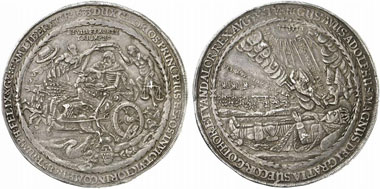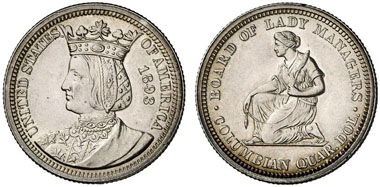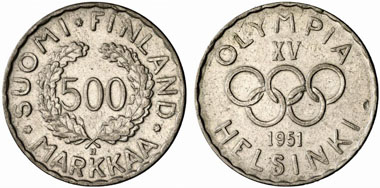by Richard Giedroyc
August 14, 2012 – Commemorative coins are favored by governments worldwide not because they necessarily commemorate a person, place, or event, but because commemoratives are a source of revenue. Even countries that have a difficult time obtaining hard currency in exchange for their non-convertible currency such as Cuba and North Korea have issued significant numbers of commemoratives meant to attract the hard currencies of buyers from elsewhere in the world.
How did commemorative coins come about, and where is this sub-industry of coin manufacturing going? The first issues of something similar to our commemorative coins were struck by the Roman emperors. The reverse of these coins changed often, sometimes portraying buildings, commemorating real or imagined military victories, proclaiming the emperor was a god, or something that basically conveyed what a nice guy the ruler was, even if he might have been a monster! The familiarity of the public with who was in charge was the true objective of these circulating commemoratives.
Commemorative coin valued at a double taler issued on the occasion of the translation of the remains of the Swedish king Gustav Adolf fallen in the Thirty Years’ War. From Künker 206 (2012), 5407.
Not before the early modern period just prior to modern coinage manufacturing techniques involving a collar German states began issuing what are the first true modern commemorative coins. These were typically large silver crown-size taler coins marking births, deaths, and marriages within the ruling family issuing these coins. Although some of these coins circulated most were obtained by wealthy individuals as collectibles or as souvenirs. The purchasing power of these talers and some of the subsequent gold issues that followed was simply too great to make these coins available to the average citizen. These tended to be special coins for special people.
There were several milestones in the modern commemorative coin field that have set the direction in which commemorative coin issuance and marketing have gone since that time. The German and other continental European commemoratives of the early modern era were meant for the wealthy during a period when the middle class was small and quite different from what it is in many parts of the world today. While many of these early modern issues were meant for presentation, the growth of the middle classes invited the issuance of commemorative coins primarily for profit rather than for propaganda purposes.
Commemorative coin struck for the Columbian Exposition in Chicago in 1893. From Künker 159 (2009), 2332.
The 1892 and 1893 US Columbian Exposition coins are a great example of this mission change and the results of this revised focus. The coins were struck by the US Mint with the intensions of selling them for more than their face value. The profit from the sale of these coins was meant to help finance the exposition being commemorated. At first the coins proved to be popular, but then sales diminished. The mint could melt the remaining coins and re-coin the metal into more useful circulating coinage, or they could release them into circulation with no further manufacturing or recycling costs to the mint. The latter route was taken, with the coins becoming relatively commonplace circulating commemoratives. This example would serve as a model for further commemorative US coin issues that did not sell out, a policy that continued until the first US commemorative coin series ended during 1954.
Finland: The first Olympian commemorative coin. From Künker 154 (2009), 1568.
A new focus for commemorative coins began when the seed was planted almost unnoticed in 1951. This was the Olympic Games commemoratives issued by Finland. The low mintage issue did not gain much attention at the time, but by 1972 the concept of raising money for the Olympic Games through commemorative coins had been adopted by Germany for the Munich Games.
Several things had changed. The spot price of silver had made silver composition coins impractical for everyday circulation. Silver commemoratives were now being made for sale to the general and for the collecting public. The concept of the non-circulating yet technically legal tender coin was in play. What hadn’t changed was the idea that a single commemorative was being issued to finance an objective. The Munich Olympics became the first instance in which a multiple of coin types were issued to raise money for the same event, the idea being that if someone purchased one coin they could be convinced they needed to complete the entire series.
In 1988 the idea of subscribing to such purchases in order to complete a set of coins was taken to a new height by the Royal Canadian Mint when offering the ambitious Calgary Olympic Games series to help finance the Games. RCM Master James Corkery and his marketing director Robert Huot invited the hobby publication press from around the world to tour the new Olympic site while unveiling the coins at ornate ceremonies to gain needed publicity for the coins. The RCM paid for the entire cost of the cross country press tour.
Readers are certainly familiar with the many modern NCLT commemorative coins now issued regularly in hopes of turning a profit from this merchandise. Some of it is issued in a rather sporadic fashion with a limited number of buyers who will have an interest in the subject of the product. Others have a wide appeal and sell more briskly.
Much of the success of the modern commemorative coin can be credited to Derek Pobjoy, master of the privately owned Pobjoy Mint in the United Kingdom. Pobjoy inherited a sword manufacturing facility, converting some of the manufacturing assets to coin production. The Pobjoy Mint soon focused their commemorative coin efforts on third world countries that required outside mints to produce their circulating coinage. Many of these countries, or rebellious political elements within these nations, were starved for cash. These political entities were often quite willing to agree to allow a foreign mint to produce commemorative coins in the name of their nation – for a price – with that foreign mint choosing the subject to be commemorated, even if that subject had no relationship to anything in the country in whose name the coins were being struck. The mint of issue gained full control of marketing and distribution through this strategy.
Today we have coins on which appear dinosaurs, racing cars, motion picture themes, dogs, cats, and other interests that may tempt a specifically targeted audience within the general rather than in the collecting public to purchase these coins. Holidays such as Christmas are marked by annual commemorative issues meant for specifically targeted audiences as well. This is the direction being taken today by sophisticated manufacturers of modern commemorative coins.
What’s ahead? There are still many mints spewing out commemoratives marking subjects of little interest to anyone other than a limited audience of traditional collectors. The US Mint, whose coin subjects are dictated by Congress, is particularly guilty of this. The focused subject and marketing appears to be the immediate way of the future. With profit as the primary motive for issuing commemorative coins today this focused marketing plan appears to be the most effective.







